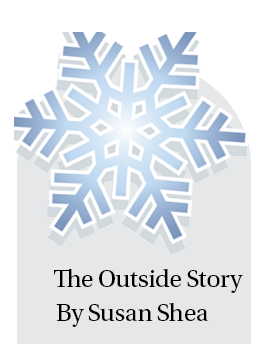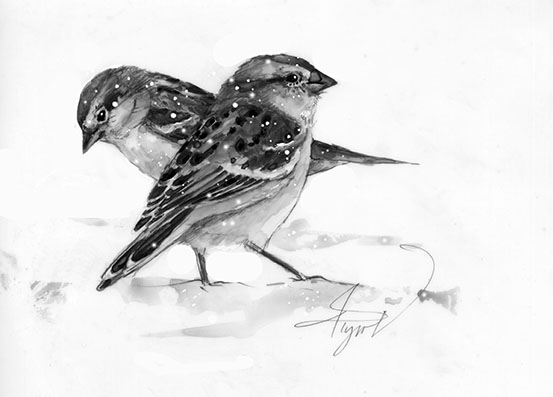
Most winters, a few sparrows visit my yard, feeding on the seeds I scatter on the ground near my bird feeder. These particular sparrows have long tails, rusty crowns and eye-lines on their gray heads, and a distinctive dark breast spot. Looking more closely, I’ve noticed buff-colored patches on the sides of their pale breasts, two white wingbars, and streaked brown backs. These birds are American tree sparrows (Spizelloides arborea), so named by European settlers who were reminded of Eurasian tree sparrows back home. The name, however, is a misnomer, as these “tree” sparrows are actually ground birds, spending little time in trees. They are also known as winter sparrows, winter chippies, or snow chippies, for their resemblance to chipping sparrows (which are smaller and do not winter here).
American tree sparrows live throughout most of North America, except for the far South and Pacific Coast. They breed across northern Canada and Alaska and winter in the northern two-thirds of the U.S., including the Northeast. In winter, roving flocks of tree sparrows frequent wind-swept weedy fields, marshes, hedgerows, woodland edges, and backyards.
They forage mainly on the ground, scratching and pecking, hopping up towards bent weeds, and even flapping their wings against plants to dislodge seeds. These birds are almost exclusively vegetarian in winter, consuming grass, sedge, goldenrod, other seeds, and occasionally berries. They will also eat insect eggs and larvae. When the ground is snow-covered, tree sparrows obtain water by eating snow. These hardy sparrows will continue foraging during blizzards. They stay in touch with other members of their flock with high, musical “see-weep” calls and fluff up their feathers so they appear quite plump. Tree sparrows have been observed roosting communally under the snow.
In March or April, flocks of tree sparrows depart for the long, sometimes perilous migration to their breeding grounds in northern Canada or Alaska. They travel 1,500 to 3,000 miles, usually at night. Upon reaching the northern treeline of the boreal forest at the edge of the tundra, flocks disperse, and individuals pair up. The male courts the female and defends his territory with song—a clear, high warble with a descending trend.
The female builds a nest on tussocks of tundra grass, or close to the ground among stunted spruce and birch or in alder or willow thickets. The nest is an open cup of grasses, bark strips, twigs, and moss and is lined with fine grass and ptarmigan feathers. In it, the female lays four to six pale blue eggs with reddish speckles. In summer, the tree sparrow changes its diet, feeding mostly on a wide variety of insects, spiders, and snails, and providing these protein-rich foods to its growing young. The parents must watch for predators such as hawks, owls, weasels, and red squirrels.
Although tree sparrows are still numerous throughout their range, annual Christmas Bird Count data show that winter populations have decreased significantly in the past 50 years. Partners in Flight, a global network of bird conservation organizations, includes the species on its list of common birds in steep decline. Tree sparrows are generally undisturbed by humans on their remote northern nesting grounds and in winter seem to adjust easily to habitats near human settlements, so the reason for their decline is not clear. One theory is that intensified agriculture in the Midwest and Plains States has eliminated much of the weedy and brushy habitat needed by wintering birds. In the Northeast, development and maturation of forests may have had a similar effect. Climate change could also be affecting their nesting habitat or reproductive success.
If you’d like to help wintering tree sparrows by feeding them, remember to clean feeders regularly and to keep cats indoors. These sparrows prefer platform and other tray feeders or ground feeding. They will come to black oil sunflower seed, thistle seed, cracked corn, peanut hearts, and millet.
Watch for these hardy visitors from the North in your yard this winter.
Susan Shea is a naturalist, writer, and conservationist based in Vermont. Illustration by Adelaide Murphy Tyrol. The Outside Story is assigned and edited by Northern Woodlands magazine and sponsored by the Wellborn Ecology Fund of the New Hampshire Charitable Foundation: nhcf.org.




